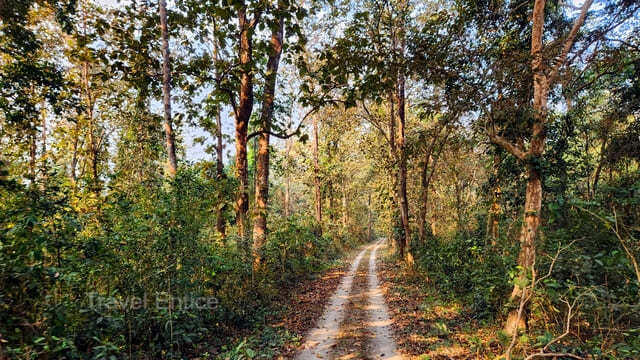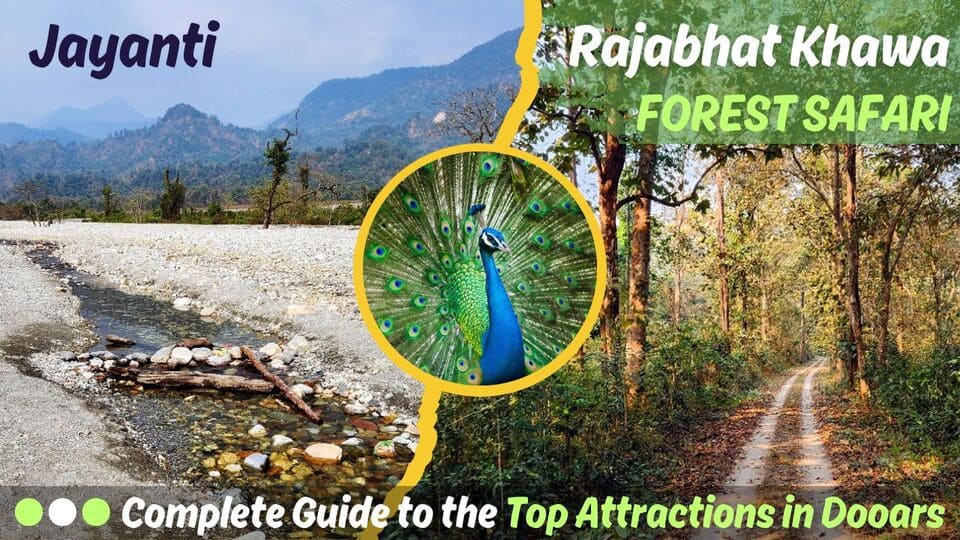Nestled on the fringes of the Buxa Forest, Jayanti is a charming forest village embraced by the serenity of the Jayanti River. The picturesque Jayanti River forms a natural border between Indian plane land and Indo-Bhutanese hilly landscape; along the site the eastern slopes are christened the Jayanti Hills, while the quaint settlements on the western banks are aptly named Jayanti villages, paying homage to the river’s name.
Owing to its breathtaking vistas, lush greenery all around, enchanting verdure, and serene atmosphere, Jayanti is proudly known as the “Queen of Dooars”, captivating thousands of visitors every year with its allure.
Brief History of Jayanti
During British colonial rule, Jayanti emerged as a significant hub for mining and tea industries in India, crucial for British finances. However, as the European tea and mining industry expanded, supplying commodities became challenging. The construction of Jayanti Railway commenced in 1901 after approval from the king of Cooch Behar, Maharaja Nripendra Narayan.
Passenger train service started post-independence, operating between Alipurduar Junction and Jayanti, but ceased with the establishment of Buxa Tiger Reserve in 1986. Today, the railway bridge over Jayanti River lies in ruins, with only remnants visible due to shallow waters caused by accumulated pebbles and rocks.
Related Article: Charkhole — A promising offbeat destination
Things to do in Jayanti
Jayanti, among the oldest towns in Dooars, has transformed into a tranquil village, brimming with vibrant ecology and endless greenery. Nature’s purity blossoms in every corner of this quaint hamlet, providing a refreshing escape away from monotonous city life. For nature enthusiasts, Jayanti serves as an ideal weekend getaway, allowing you to rejuvenate amidst the lush embrace of nature.
Now, let’s explore a brief list of things to do in Jayanti.
Embark on a forest road trip

The journey to Jayanti unfolds through the lush forest, which is a safe home of elephants, deer, peacocks, bison, and many more wilds. As you traverse these forested roads, keep a keen eye out for wildlife sightings if fortune favors. Remember to drive slowly, maintain a low voice, and refrain from playing music in your car.
In case you see a wild on the road or road-side forest, must exercise caution and maintain a safe distance, particularly in the case of elephants. Avoid approaching them closely, as this could provoke aggression.
In addition to the mesmerizing forest scenery, the journey includes crossing the Balason River, offering an ideal opportunity to capture some stunning photographs.
You may like: Chimney Park, Kurseong: Explore the historic charm
Discover the beauty of the Jayanti River

Jayanti River is situated at the edge of Jayanti village. Spanning nearly 1 kilometer in width, the riverbed remains typically dry most of the time of the year. However, the presence of white pebbles lends a unique charm to the landscape, complemented by the picturesque backdrop of the Bhutan Hills.
During the monsoon season, the water level of the river rises, occasionally overflowing its banks. It’s an unparalleled experience to listen to the mesmerizing sound of the flowing river, accompanied by the melodic chirping of unknown birds, all while being caressed by the refreshingly cool breeze of the riverside.
Also explore: Rangli Rangliot Tea Garden
Enjoy the thrill of RajabhatKhawa Forest Safari

Rajabhat Khawa forest safari is the most alluring thing to do in Jayanti. This dense and expansive forest teems with plentiful wildlife, including peacocks, deer, and elephants. Occasionally you can see bison also.
To embark on this adventure, you’ll need to secure safari tickets from the forest office near the entrance of the Jayanti forest range.
Each safari jeep, accommodating up to 6 tourists, costs around 4000/- for a 1.5-hour excursion. If you’re traveling solo, consider joining forces with another small group to share the cost. Safari bookings are available from 8:30 AM to 3:00 PM daily.
Once you are inside the forest, maintain silence to respect the natural habitat of the wildlife. The safari jeep follows a specific route through the dense forest; sometimes spotting hidden wilds can be challenging, although safari pilots try their best to spot them to make your trip memorable. If you’re fortunate, you may catch glimpses of wildlife along the way. Regardless, the sheer beauty of the forest is a reward in itself.
Halfway through the safari, you’ll be dropped off at the salt lick, where vegetarian wilds often congregate. This presents an excellent opportunity to observe wildlife up close.
After spending around half an hour at the salt lick, the safari jeep will return you to the starting point, concluding your memorable journey through the Rajabhat Khawa Forest.
Explore: Lamahatta Eco Park: A Nature Lover’s Paradise
**Our Experience at Jayanti and Rajabhat Khawa Forest
During our forest safari, we were fortunate to catch sight of a majestic wild elephant, several peacocks and deer, along with a couple of bison. Despite these thrilling encounters, we cherished the moments of tranquility, basking in the unspoiled beauty of the lush forest surroundings.
Other Sightseeing around Jayanti
While the renowned Buxa Tiger Reserve Forest takes precedence among the sights near Jayanti, numerous other captivating places are waiting to be explored in the vicinity. Let’s take a look at the following list for more options:
- The Buxa Tiger Reserve
- Buxa Fort
- Mahakal Caves
- Pokhari Hills
- The Nature Interpretation Centre
- Jaldapara Wildlife Sanctuary
- Chilapata Forest
- Bhutan
- Chapramari Wildlife Sanctuary
How to Reach Jayanti & Rajabhat Khawa
There are multiple routes to reach the forest village of Jayanti; the easiest route is via the Alipurduar-Jayanti route, just 30 kilometers from Alipurduar town. Alternatively, you can also reach Jayanti from Jaldapara, which is 65 kilometers away from the forest village.
From the entrance of Jayanti forest range, you can book ticket for Rajabhat Khawa forest safari. The details are highlighted in the above section.
Related: Netarhat: The Queen of Chhotanagpur
Where to stay at Jayanti
Several hotels and homestays are available in Jayanti. The finest accommodations are outlined below.
- JSGS – Homestay
- Sakuntala Homestay (9775482189)
- Aaltapori Homestay (81018 30794)
- Banante Resort (92305 43807)
- Mohanchura Homestay (98320 90500)
- Jayanti Riverview Homestay
- Jayanti Eco villa
Many tourists opt to explore Dooars with Jaldapara as their base point. If you’re considering the same, here are some top resorts and homestays in Jaldapara:
- Orchid Homestay
- Hollong Tourist Lodge
- Villa de Hollong
- Rhino Cottage
- Jaldapara Forest Tourist Lodge
- Wild Hut
- Jaldapara Golden Resort
You also have the option to embark on a one-day trip to Jayanti from Alipurduar. Here are some renowned hotels in Alipurduar:
- Hotel Bangabhumi
- Hotel Dooars Mountain
- Maa International
- Hotel Elite
Conclusive remarks
Jayanti offers a mesmerizing blend of natural beauty and wildlife encounters. From the serene Jayanti River to the dense forests teeming with diverse flora and fauna, these destinations captivate visitors with their allure. Whether you’re exploring the lush landscapes or embarking on a thrilling safari at Rajabhat Khawa forest, a trip to Jayanti ensures unforgettable experiences amidst the untouched wilderness of Dooars.
Dr. Suvankar Das is a scientific advisor by profession, associated with a CRO organization. He pursued his doctoral degree in Chemistry in 2015. Later, he worked as a postdoctoral researcher & scientist in a couple of institutes/companies.
Besides his scientific journey, Dr. Das is also a passionate traveler and travel blogger. He loves to share all his travel experiences with other travelers so that everyone can enjoy hassle-free holidays with their own tour plans.
He believes, the most beautiful thing in this world is the WORLD itself. so there is no way to live like a clock; rather live it like a compass!







![Anjuna Beach in Goa: Is it worth visiting? [Full Details] 11 Read more about the article Anjuna Beach in Goa: Is it worth visiting? [Full Details]](https://travelentice.com/wp-content/uploads/2022/12/Anjuna-Beach-in-Goa-300x169.jpg)